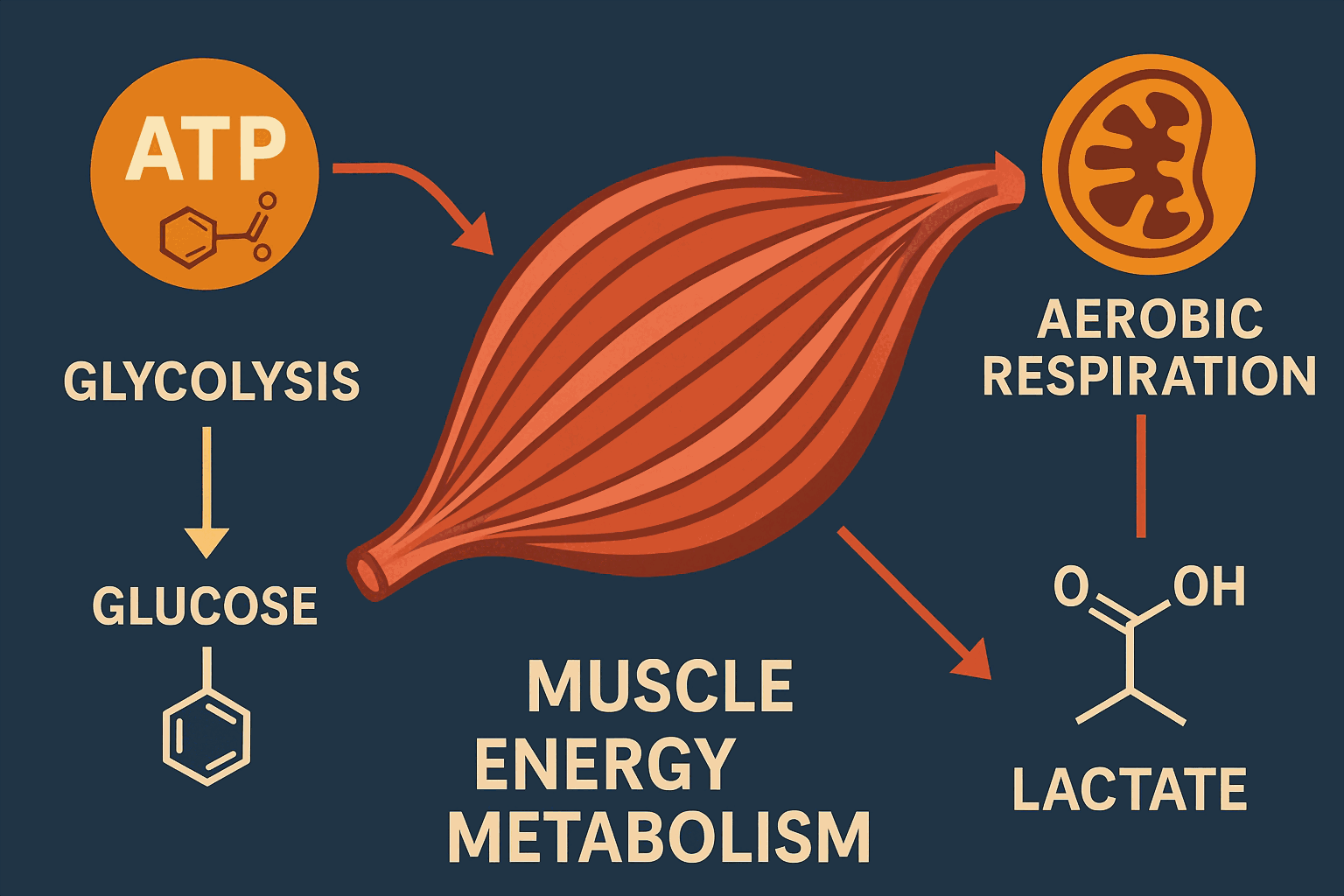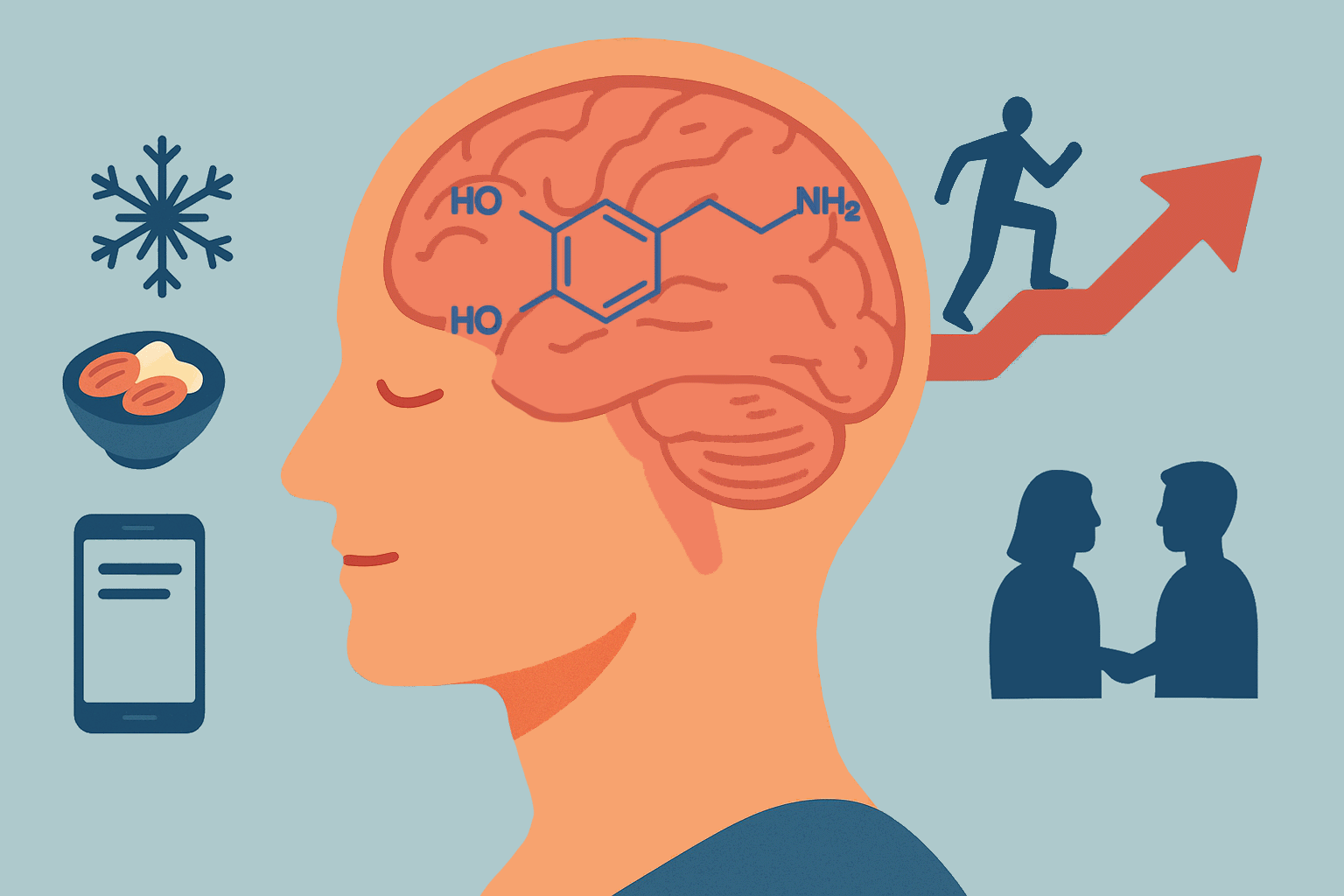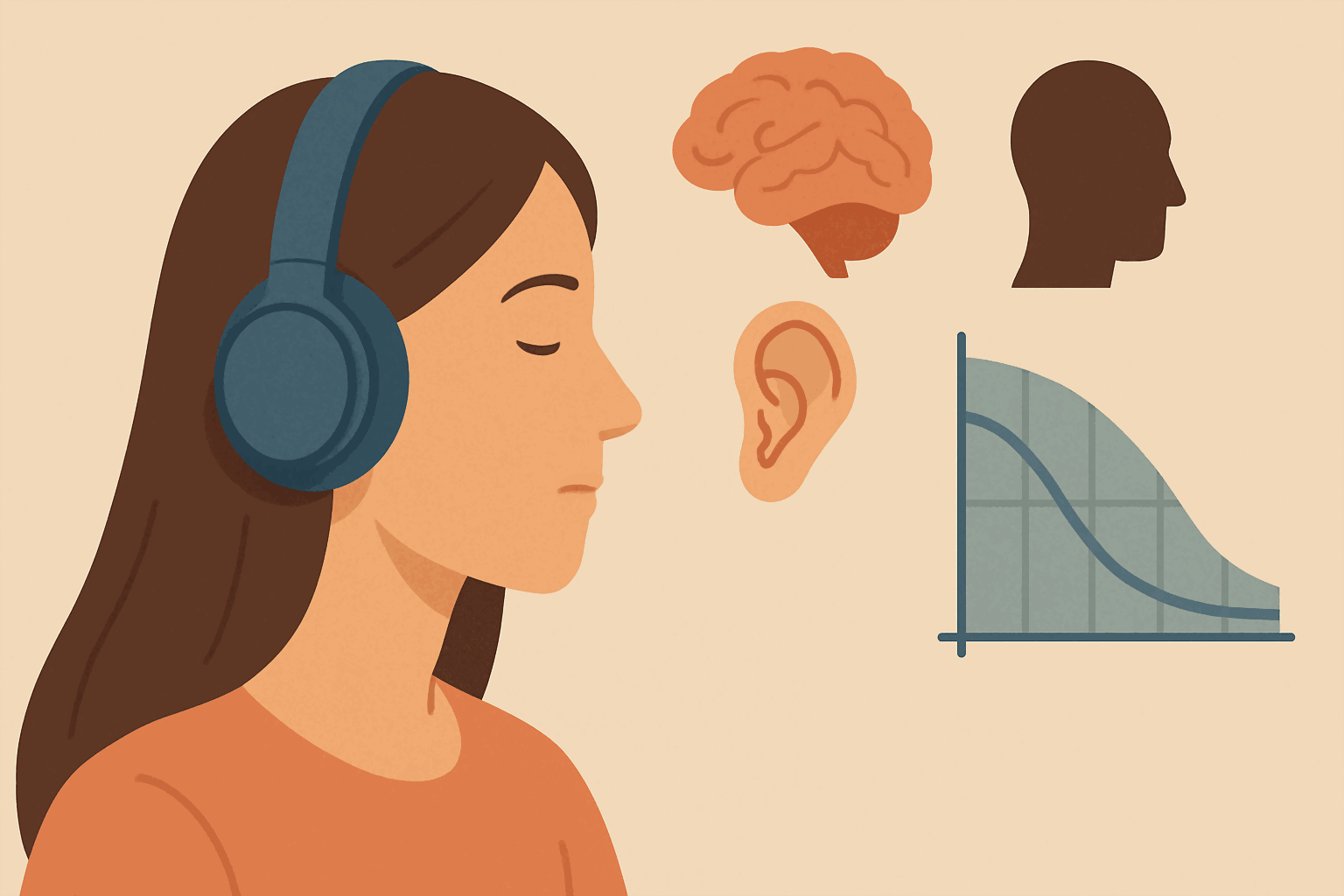
Muscle Energy Metabolism: Fueling Peak Performance and Brain Health
- Ethan Brooks
- Exercise science , Physiology , Health & wellness
- May 9, 2025
Table of Contents
Fast Facts: Fueling Your Body
- ATP is King: Adenosine Triphosphate (ATP) is the direct energy currency for all muscle contractions.
- Three Energy Systems: Muscles use three main systems to generate ATP: the phosphagen system, anaerobic glycolysis, and aerobic oxidation.
- Short Bursts, Quick Energy: The phosphagen system provides immediate ATP for ultra-short, explosive movements (e.g., a heavy lift, sprint start).
- Fast Energy, No Oxygen: Anaerobic glycolysis rapidly produces ATP from glucose without oxygen, fueling intense efforts for a few minutes and producing lactate.
- Sustained Power: Aerobic oxidation generates the most ATP using oxygen, ideal for endurance activities, utilizing carbohydrates, fats, and sometimes protein.
- Lactate is a Hero, Not a Villain: Far from just a waste product, lactate is a valuable fuel source, a signaling molecule, and may even protect against acidity during intense exercise.
- Lactate Boosts Brain Power: Lactate produced during intense exercise supports brain function and neuroplasticity, enhancing cognitive flexibility.
- Train Smart: Different types of exercise preferentially train different energy systems, leading to specific adaptations for strength, power, and endurance.
Introduction: The Powerhouse Within
Our muscles are incredible engines, capable of everything from delicate movements to explosive displays of power. But like any engine, they need fuel. Understanding how our muscles generate and use energy – a field known as energy metabolism – is not just for athletes; it’s crucial for anyone interested in improving their physical performance, overall health, and even cognitive function. The intricate processes within our muscle cells determine our stamina, strength, and how our bodies respond to different types of exercise. As we delve into this topic, it’s clear that skeletal muscle is not just for movement; its metabolic health and endocrine functions have wide-reaching impacts on the entire body [1].
This article, grounded in science and evidence-based medicine, will unravel the fascinating world of muscle energy metabolism. We’ll explore the primary pathways muscles use to produce Adenosine Triphosphate (ATP) – the body’s energy currency – and demystify the often-misunderstood role of lactate.
ATP: The Universal Energy Currency
At the heart of muscle contraction, and indeed almost all cellular processes, is Adenosine Triphosphate (ATP). Think of ATP as the rechargeable battery that powers cellular work. When ATP breaks down into Adenosine Diphosphate ($ADP$) and an inorganic phosphate ($P_i$), it releases energy that muscles use to contract. However, our muscles store only a very small amount of ATP, enough for just a few seconds of intense activity. Therefore, to sustain muscle work, ATP must be continuously regenerated. This is where the body’s sophisticated energy systems come into play.
How Muscles Generate ATP: The Three Key Energy Systems
Muscles primarily rely on three interconnected systems to replenish ATP, each suited to different demands of intensity and duration:
1. The Phosphagen System (ATP-PCr System)
Speed: Immediate, very rapid
ATPproduction.Fuel: Stored phosphocreatine (PCr).
When it’s used: For short, explosive activities lasting up to about 10-15 seconds, like a single heavy lift, a short sprint (e.g., 100m dash), or throwing [2, 3].
Mechanism: This anaerobic system (doesn’t require oxygen) uses the enzyme creatine kinase to break down phosphocreatine ($PCr$). The phosphate group released quickly combines with $ADP$ to regenerate
ATP.$PCr + ADP \rightarrow ATP + Creatine$
Capacity: Limited by the small stores of $PCr$ in the muscle.
2. Anaerobic Glycolysis (Lactic Acid System)
Speed: Rapid
ATPproduction.Fuel: Glucose (from blood sugar) or glycogen (stored glucose in muscles).
When it’s used: For high-intensity activities lasting from about 15 seconds up to 2-3 minutes, such as a 400-meter sprint, or a set of multiple repetitions in weightlifting [4].
Mechanism: This pathway breaks down glucose or glycogen into pyruvate. In the absence of sufficient oxygen to process pyruvate further through aerobic pathways (or when energy demand is very high), pyruvate is converted to lactate. This process yields a net of 2
ATPmolecules per glucose molecule (or 3 from glycogen). While less efficient than aerobic metabolism, glycolysis is about 100 times faster at producingATP[4].$Glucose \rightarrow 2 Pyruvate + 2 ATP + 2 NADH$
$Pyruvate + NADH \rightarrow Lactate + NAD^+$ (regenerating $NAD^+$ for glycolysis to continue)
Byproduct: Lactate (often referred to as lactic acid, though at physiological pH, it’s mainly lactate).
3. Aerobic Oxidation (Cellular Respiration)
- Speed: Slower
ATPproduction but much higher yield. - Fuel: Primarily glucose, glycogen, and fatty acids. Amino acids (from protein) can also be used, especially during prolonged exercise or caloric deficit.
- When it’s used: For lower to moderate-intensity activities lasting longer than a few minutes, and for endurance events like long-distance running, cycling, or swimming. This system is also crucial for recovery from high-intensity efforts [5].
- Mechanism: This complex, oxygen-dependent process occurs within the mitochondria – the “powerhouses” of the cell. It involves several stages:
- Glycolysis (aerobic context): Pyruvate produced from glucose breakdown enters the mitochondria.
- Pyruvate Oxidation: Pyruvate is converted to Acetyl-CoA.
- Krebs Cycle (Citric Acid Cycle): Acetyl-CoA enters this cycle, producing some
ATP, and importantly, electron carriers ($NADH$ and $FADH_2$). - Oxidative Phosphorylation (Electron Transport Chain): The electron carriers donate electrons through a series of protein complexes. This process drives the pumping of hydrogen ions, creating a gradient that powers the synthesis of a large amount of
ATP(around 30-32ATPmolecules per glucose molecule) [4, 5]. Water is formed as a byproduct when oxygen accepts electrons.
- Efficiency: The most efficient system for
ATPproduction, allowing for sustained activity.
Lactate: A Misunderstood Hero in Muscle Metabolism
For decades, lactate (often mistakenly called “lactic acid”) was viewed as a metabolic villain – a waste product responsible for muscle burn, fatigue, and soreness. However, modern science has dramatically reshaped this understanding, revealing lactate as a key player in energy metabolism and cellular signaling [6].
Formation Revisited: Lactate isn’t solely formed due to a lack of oxygen. During intense exercise, even if oxygen is available, the rate of glycolysis can outpace the capacity of mitochondria to use pyruvate for aerobic respiration. This results in pyruvate being converted to lactate, which crucially regenerates $NAD^+$, allowing glycolysis to continue supplying
ATPrapidly [4].Not the Cause of Fatigue: While lactate accumulation often coincides with fatigue during intense exercise, it’s not the primary cause. Fatigue is a complex phenomenon involving multiple factors, including the accumulation of hydrogen ions ($H^+$) (which can lower muscle pH), depletion of energy substrates, and central nervous system factors [7]. In fact, lactate production can help buffer against rising acidity.
A Valuable Fuel Source:
- Direct Use: Muscle cells (especially slow-twitch oxidative fibers) and the heart can take up lactate from the bloodstream and convert it back to pyruvate, which then enters the aerobic pathway to produce
ATP[6]. This is known as the “lactate shuttle.” - Cori Cycle: Lactate can travel to the liver, where it’s converted back into glucose through a process called gluconeogenesis. This newly formed glucose can then be released back into the bloodstream to fuel working muscles or be stored as glycogen [8, 9]. This shifts some of the metabolic burden from the muscles to the liver.
- Direct Use: Muscle cells (especially slow-twitch oxidative fibers) and the heart can take up lactate from the bloodstream and convert it back to pyruvate, which then enters the aerobic pathway to produce
Buffering Role: The process of lactate production consumes $H^+$ ions. While high rates of
ATPbreakdown during intense exercise release $H^+$ leading to acidosis, lactate itself is not the primary acidifier. Training can improve the body’s capacity to buffer acidity and clear lactate [10].Signaling Molecule (Lactormone/Myokine): Emerging research shows that lactate acts as a signaling molecule, or “lactormone,” influencing various tissues and processes throughout the body [11]. It can affect:
- Metabolic Regulation: Influencing how other tissues use fuel.
- Inflammation and Healing: Playing roles in immune response and tissue repair.
- Endocrine Function: Communicating with other organs like the heart, liver, and brain.
Brain Health and Neuroplasticity: This is one of the most exciting areas of lactate research.
- Brain Fuel: The brain can use lactate as an energy source, particularly during intense exercise when blood lactate levels rise. Astrocytes, a type of glial cell in the brain, can produce lactate and supply it to neurons [12].
- Enhanced Neuroplasticity: Intensive training that leads to lactate accumulation has been linked to enhanced neuroplasticity – the brain’s ability to reorganize itself by forming new neural connections. This can improve cognitive functions like learning, memory, and cognitive flexibility [12, 13]. Exercise, potentially through mechanisms involving lactate and other factors like improved gut-brain axis communication, plays a significant role in overall brain health [14].
Training Adaptations: Tailoring Exercise for Optimal Energy and Health
Understanding these energy systems allows us to tailor exercise programs to achieve specific fitness goals:
Aerobic Training (Endurance Exercise):
- Enhances the aerobic oxidation pathway by increasing mitochondrial density and efficiency in muscle cells [5, 10].
- Improves the body’s ability to use fat as a fuel source, sparing glycogen.
- Increases capillary density in muscles, improving oxygen delivery.
- Boosts the capacity to clear and utilize lactate.
Anaerobic Training (Strength, Power, and High-Intensity Interval Training - HIIT):
- Increases the stores of
ATPand $PCr$ in muscles, enhancing the phosphagen system [10]. - Improves the capacity of the glycolytic pathway, allowing for greater production of
ATPanaerobically. - Leads to muscle hypertrophy (growth), increasing overall strength and power.
- Enhances the body’s ability to buffer acidity.
- Stimulates the release of lactate, contributing to its associated benefits, including potential neuroplastic changes [12, 13]. Strength training also offers broad benefits for metabolic health, including improved insulin sensitivity and glucose metabolism, bone density, and functional strength [15].
- Increases the stores of
The Synergy of Both: A balanced fitness routine that incorporates both aerobic and anaerobic training is ideal for overall health and performance. Aerobic fitness supports recovery from anaerobic efforts, while strength provides the foundation for powerful movements and injury prevention.
Conclusion: Harnessing Your Metabolic Power
The energy metabolism within our muscles is a dynamic and sophisticated symphony of biochemical reactions. From the instantaneous burst of power provided by the phosphagen system to the sustained endurance fueled by aerobic oxidation, and the surprisingly beneficial roles of lactate, these processes are fundamental to how we move, perform, and thrive.
By understanding these mechanisms, we can appreciate the science behind different training methods and make informed choices to optimize our energy systems, enhance physical and cognitive performance, and support long-term health. Whether you’re an elite athlete or simply seeking a healthier lifestyle, recognizing the power within your muscles is the first step to unlocking your full potential.
Disclaimer
The information provided on BioBrain is intended for educational purposes only and is grounded in science, common sense, and evidence-based medicine. It is not a substitute for professional medical advice, diagnosis, or treatment. Always consult a qualified healthcare provider before making significant changes to your diet, exercise routine, or overall health plan.
References
- Wright, H. L., et al. (2016) "The Emerging Role of Skeletal Muscle Metabolism as a Biological Target and Cellular Regulator of Cancer-Induced Muscle Wasting"
- Kent, M. (2006) "ATP-PCr system (phosphagen system)"
- Baker, J. S., McCormick, M. C., & Robergs, R. A. (2010) "Interaction among Skeletal Muscle Metabolic Energy Systems during Intense Exercise"
- Javed, M., & Hilli, F. A. (2023) "Biochemistry, Anaerobic Glycolysis"
- Hargreaves, M., & Spriet, L. L. (2020) "Skeletal muscle energy metabolism during exercise"
- Brooks, G. A. (2020) "Lactate as a Fulcrum of Metabolism"
- Allen, D. G., Lamb, G. D., & Westerblad, H. (2008) "Skeletal muscle fatigue: cellular mechanisms"
- PubChem "Cori cycle"
- Wikipedia contributors (2024) "Cori cycle"
- PT Direct "Metabolic Adaptations to Exercise"
- Ferguson, B. S., Rogatzki, M. J., Goodwin, M. L., Kane, D. A., Rightmire, Z., & Gladden, L. B. (2018) "Lactate as a Myokine and Exerkine: Drivers and Signals of Physiology and Metabolism"
- El Hayek, L., et al. (2019) "Lactate Mediates the Effects of Exercise on Learning and Memory through PGC-1α and BDNF"
- Dehghan, F., & Keshvari, M. (2021) "Neuroplastic Effect of Exercise Through Astrocytes Activation and Cellular Crosstalk"
- Simpson, C.A., & Mohammadi, E. (2024) "Exercise for Brain Health: The Role of Gut-Brain Axis and Inflammatory Pathways"
- El Camino Health "More than Muscle Mass: Benefits of Strength Training"
Tags :
- Muscle energy metabolism
- Atp production
- Glycolysis
- Aerobic oxidation
- Phosphagen system
- Lactate benefits
- Exercise physiology
- Neuroplasticity exercise
- Strength training
- Aerobic exercise
- Brain health



